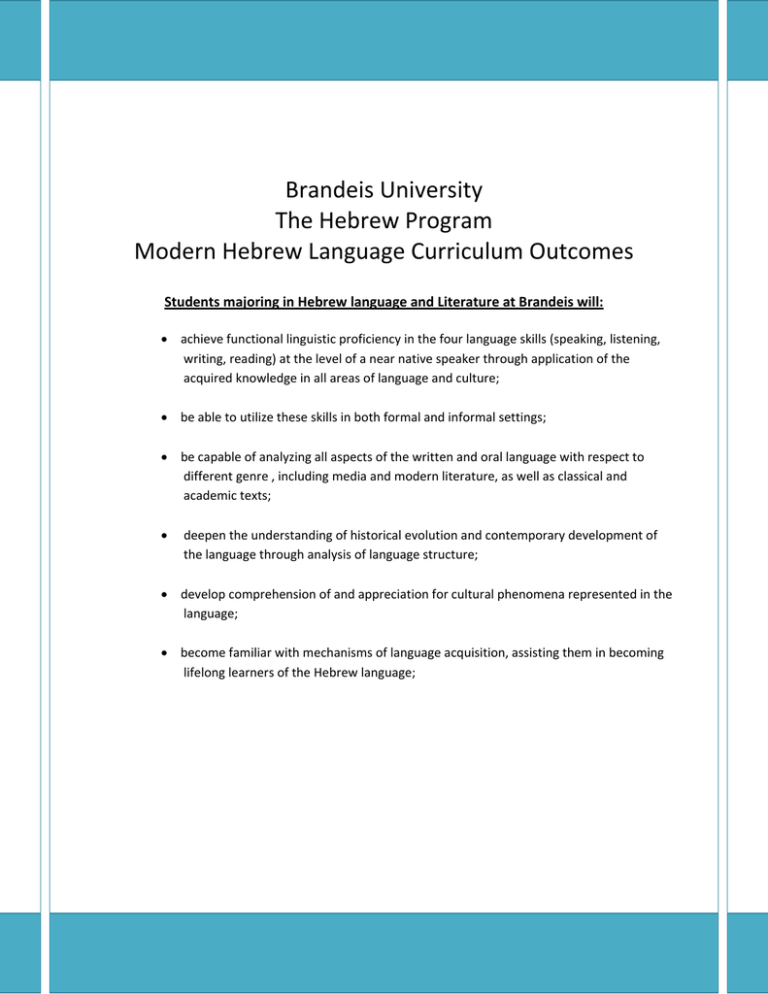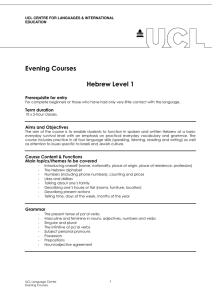Brandeis University The Hebrew Program Modern Hebrew Language Curriculum Outcomes
advertisement

Brandeis University The Hebrew Program Modern Hebrew Language Curriculum Outcomes Students majoring in Hebrew language and Literature at Brandeis will: achieve functional linguistic proficiency in the four language skills (speaking, listening, writing, reading) at the level of a near native speaker through application of the acquired knowledge in all areas of language and culture; be able to utilize these skills in both formal and informal settings; be capable of analyzing all aspects of the written and oral language with respect to different genre , including media and modern literature, as well as classical and academic texts; deepen the understanding of historical evolution and contemporary development of the language through analysis of language structure; develop comprehension of and appreciation for cultural phenomena represented in the language; become familiar with mechanisms of language acquisition, assisting them in becoming lifelong learners of the Hebrew language; Introduction to the learning goals: The publication of the Hebrew Proficiency guidelines in 1990 ( By the Hebrew program at Brandeis in Collaboration with The American Council on the Teaching of Foreign Languages) have helped us gain a better understanding of the characteristic stages of linguistic behavior that non native usually follows from “no communication in Hebrew” ( the Novice level ) to “native‐ like competence” ( the superior level). These guidelines opened the way for more realistic assessment of functional proficiency in all four skills obtainable through instruction in any academic framework. Since our curriculum was inspired by The Hebrew proficiency Guidelines, and therefore is written in terms of “student outcomes, i.e. it describes not what we hope to achieve, but what students actually learned and were able to do after each period of instruction. The curriculum assumes 14 weeks of instruction either six or four hours weekly (depends on the level) including the number of contact hours both in the classroom and outside the classroom. In order to get a true indication of what they have learned both achievements and proficiency exams need to be included in the curriculum. The curriculum for the first three semesters was written with equal emphasis on all four skills. Starting from the 4th semester there are courses that emphasize one specific skill e.g. reading, speaking, writing over the others. Since there is a difference between the pace of the acquisition of productive skills ( speaking and writing) and the receptive skills (reading and listening) the expected levels of outcomes are articulated in terms of range of levels . In order to clarify the exact expectation, we articulated the outcomes’ goals for each of the language skills. Each goal articulation includes the following criteria: Content/context, Tasks, Text –type and accuracy. In order to get a true indication of both student progress and outcome exams need to be included in the curriculum. Students are encouraged to be active participants in their own learning. We hope that the articulation of the learning goals will help our students develop realistic expectations regarding the proficiency achievable in a specified number of hours of study. They need to understand that learning a foreign language is a life‐long endeavor. 2 First semester – 5 units – approximately Expected outcomes: By the end of the semester, students are expected to have reached proficiency level of Novice – High in speaking and writing (according to the ACTFL guidlines – see below) and proficiency level of Intermediate‐Low in reading and listening (according to the ACTFL guidelines). Speaking: “Able to satisfy partially the requirements of basic communicative exchanges by relying heavily on learned utterances but occasionally expanding these through simple recombination of their elements. Can ask questions or make statements involving learned material. Shows signs of spontaneity although this falls short of real autonomy of expression. Speech mainly consists of learned utterances rather than of personalized ones, Vocabulary centers on areas such as basic objects, places, and most common kinship terms.” (ACTFL GUIDELINES ) Writing: “Able to write simple, fixed expressions and limited memorized materials and some recombinations thereof. Can supply information on simple forms and documents. Can write names, numbers, dates, own nationality, and other simple autobiographical information, as well as some short phrases and simple lists. Can write all the symbols in an alphabetic system.” (ACTFL GUIDELINES ) Reading: “Able to understand main ideas and/or some facts from the simplest connected texts dealing with basic personal and social needs. Such texts are linguistically noncomplex and have a clear underlying internal structure, for example, chronological sequencing. They impart basic information about which the reader has to make only minimal suppositions or to which the reader brings personal interest and/or knowledge. Examples include messages with social purposes and information for the widest possible audience, such as public announcements and short, straightforward instructions dealing with public life.” (ACTFL GUIDELINES ) 3 Listening “Able to understand sentence-length utterances which consist of recombination of learned elements in a limited number of content areas, particularly if strongly supported by the situational context. Content refers to basic personal background and needs, social conventions and routine tasks, such as getting meals and receiving simple instructions and directions. Listening tasks pertain primarily to spontaneous face-to-face conversations.” (ACTFL GUIDELINES) The following is a description of specific outcome goals for each unit we teach during the first semester. Each unit is described by the same criteria used in the proficiency guidelines. In addition we describe how each unit will advance learners in terms of their abilities to understand and use the Hebrew grammar. We also add “cultural outcomes’ to each of the units. Since language is embedded in the culture, each unit presents us with the opportunity to expose, teach, and practice cultural components related to Hebrew. 4 Unit 1: “Getting Acquainted”: (10 hours - 1,5 weeks) By the end of the unit most of the students will be able to: Speaking: Introduce themselves by name, address, status. Ask others where they are from, Use simple greetings, and typical expressions. Inquire about someone’s health Pronounce names of cities, countries and languages. Listening: Demonstrate comprehension of the above material and to respond to it. Recognize authenticity of materials of this kind (e.g. the opening moments of a television quiz show) Writing: Control of the Hebrew alphabet in script. Write down memorized materials in the form of lists or short sentences. Answer questions and compose questions to given answers. Reading: Recognize the alphabet in print and script. Comprehend unvocalized memorized materials and cognate words as well as authentic materials such as a charts of cities in Israel, the names of the days of the week and the months from a calendar and so on.) Culture: Become familiar with facts about main cities in Israel, Find their location and recognize their names on the map. Recognize names of neighboring countries. Recognize modern Hebrew names, biblical names. Recognize dates in Hebrew Know the numerical value of the Hebrew letters. 5 Grammar/context: Identify, and use in simple utterance the, Simple (Pa’al) verbs, regular and irregular . in present tense in all forms Use the inflection of the noun ( singular) in \familiar vocabulary. Conjunction of the Vav. Have the initial tools for using a dictionary Unit 2:“Learning environment”: (18 hours - 3 weeks) By the end of the unit most of the learners will be able to do the following: Speaking: Name objects in the classroom, in their rooms, in their house, apartment or dorm Describe the above items using simple adjectives Tell their subjects and places of study Tell where someone is coming from. Express simple wishes. Listening: Fully comprehend the above materials when expressed by the teacher or the fellow students. Partially understand the above materials, main ideas and few supporting details, when listening to semi authentic texts such as clips form Israeli TV, or a speech of a native speaker who is not involved in their learning process. Writing: Reproduce memorized materials, in a form of lists or in a form of recombined memorized phrases. Write short original description of their own environments (room, classroom) using the constructions they have learned including short simple sentences. Reading: Comprehend the main idea and many supporting details of authentic texts such as ads in the newspaper, forms and so on. 6 Culture: Use idiomatic expressions (classroom). Understand the school system in Israel. Become familiar with rabbinic quotes about the ethic of the fathers (related to learning.) Become familiar with places of interest in Israel such as the Diaspora Museum in Tel Aviv. Grammar/structure: This unit includes many linguistic components of advanced learners from Novice to Intermediate level. By the end of this unit students will learn about: The Indicative pronouns. Plural Pronouns. The root and the verb system Adjectives, singular and plural. Nouns: singular and plural, Additional regular Pa’al verbs in present tense Irregular Pa’al verbs in present tense The define direct object marker About the verb “ to speak” ( Pie’el) The preposition “in/at”. Unit 3: “ Living environment” By the end of unit most of the learners will be able to: Speaking: Tell about the details of their place of living ( apt. dooms, and city) using combined short simple sentences. Tell what they like and dislike doing in these places using simple learned vocabulary and verbs. Conduct simple basic conversation needed to purchase something in a store. Listening: Fully comprehend the above materials when used by the teachers and by fellow students. Partially understand ,only main idea and few supporting details when introduced 7 through Semi authentic materials, Get the gist of an authentic text such as TV clips, radio announcements , or a speech of a native speaker who is not accounted to converse with Hebrew learners. Writing: Produce a short composition that consists of 10-12 strings of simple and combined sentences, using the learned materials. Reading: Partially understand semi - authentic text , ( main idea and some supporting details) when reading short items such as an easy newspaper that was created for learners of Hebrew.. Get the gist of the main idea when reading a short authentic text, such as newspaper ads. about apartments. for rent or a short poem by Israeli poets. Grammar/structure: Identify the construct phrase. Use the possessive form of have, have not. Learn about the prepositions: to/to the, from/from the, of, et. Count until 1000. Culture: Become familiar with an apartmentt/house in Israel. Comprehend and memorized short poem about the learned topic written by the national poet, Haim Nahman Bialik. Become familiar with details related to the biography of famous people in their immediate surrounding such as Louis Brandeis, or of famous people in Israel such as Ahad Ha- am. Become familiar with the Druze community in Israel 8 Unit 4: ‘Food” By the end of the unit most of the learners will be able to: Speaking: Name items of food and describe them in simple terms, Purchase food or order a meal in a restaurant’ Express food likes and dislikes. Tell about their eating habits. Compare food in a simple way.( color , taste , size, origin) Express basic needs using the verb: “need” and be able to”. Listening: Fully comprehend the above materials when used by the teachers and by fellow students. Partially understand ,only main idea and many supporting details when introduced through Semi authentic materials, such as clips prepared for learners of Hebrew. Get the main idea and some details of an authentic text such as TV clips, radio announcements , or a speech of a native speaker who is not accounted to converse with Hebrew learners. Writing: To produce different writing genres related to food: menus, invitations for a meal, and advertisements for food as well as short passages describing their favorite restaurants , and their eating habits – using collection of short and combined simple sentences, using the verbs mainly in the present form. Reading: Partially understand semi - authentic text, ( main idea and some supporting details) when reading short items such as excerpts from a story that was adapted for learners of Hebrew. Get the gist of the main idea when reading a short authentic text, such as newspaper advertisements about food. Culture: Become familiar with Israeli food, Eating habits in Israel of the different groups who live in Israel. Understand well known songs about Israeli food. 9 Shopping for food in Israel. Grammar/structure: Use the verbs: need and to have, can /be able to Comprehend and memorize the infinitive of regular and irregular verbs in Pa’al. Use the phrase “give me” in different contexts related to food. Unit 5 “The family” By the end of the unit most of the learners will be able to : Speaking: Describe their families ( age , dates of birth material status,) Describe family relations, and origins Inquire about someone else’s family. Tell about family traditions and events in a simple way, using short and recombined sentences and phrases, mainly in the recent test. Listening: Fully comprehend the above materials when used by the teachers and by fellow students. Partially understand ,only main idea and few supporting details when introduced through Semi authentic materials, Get the gist of an authentic text such as TV clips, songs , or a speech of a native speaker who is not accounted to converse with Hebrew learners. Writing: Write a short composition on the topic, giving information about family members, their descriptions, their likes and dislikes; compare between them in a very simple way. Tell about events and family habits, using simple and combined sentences mainly in the present tense – producing 15-28 sentences. Reading: Partially understand semi-authentic text, (main idea and many supporting details) when reading short items such as excerpts from a story that was adapted for learners of Hebrew. Get the main idea and some supporting details when reading a short edited authentic text from Israeli newspapers on topics such as: life expectancy in a kibbutz, working 10 mothers in Israel, and so on. Culture: Use common expressions used in the context of the “family”. Become familiar with family stories from different ethnic origins. Become familiar with the content of biblical stories about families ( Noah , Ruth) Become familiar with announcements regarding family in Israel ( wedding, birth, congratulations,) Get the idea about motherhood in Israel ( through short edited authentic articles). Grammar / structure: Use specific linguistic structures related to the topics ( such as “I was born” ,”how old are you”?) Use the pronominal possessive suffixes, singular. Identify and occasionally use the past tense of the regular verbs.( Pa’al) Identify and occasionally use the past tense of the irregular verbs.( Pa’al) 11




